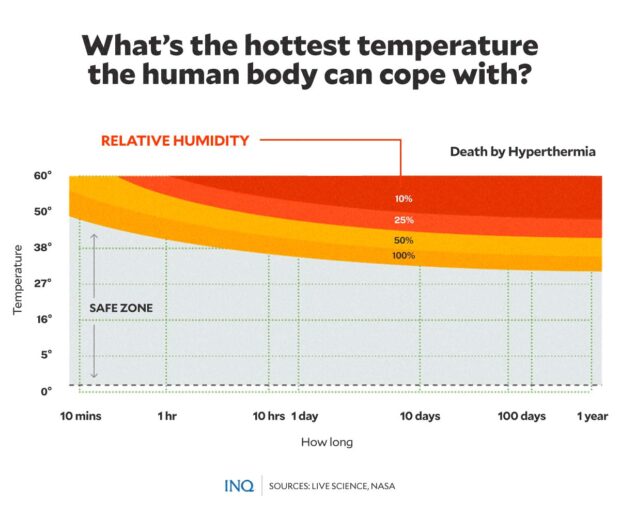Hyperthermia: When extreme heat kills
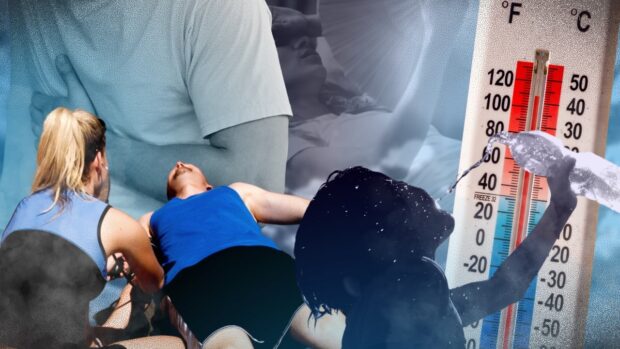
COMPOSITE IMAGE BY JEROME CRISTOBAL FROM INQ STOCK PHOTOS
MANILA, Philippines—Over a month since the state weather bureau officially declared the start of warm and dry weather in the Philippines, the country continues to experience sweltering temperatures—pushing people to find ways to escape the blanket of heat.
On March 21, Philippine Atmospheric, Geophysical, and Astronomical Services Administration (Pagasa) announced the end of the amihan or northeast monsoon season, signaling the start of the warm and dry season—often called “summer” in the country—which the weather bureau said will last until May.
From March 1 to April 30, Pagasa has recorded dangerously high heat indices across the country, ranging from 46°C up to 49°C—recorded in Guiuan, Eastern Samar on April 16.
Experts warned that when the heat index reaches dangerous levels—42°C to 51°C—people may experience heat-related illnesses, like cramps and heat exhaustion. Continued exposure could also lead to fatal heat stroke.
As the country braces for more days with hot and humid weather, a question lingers: How hot is too hot for the human body?
Article continues after this advertisementHow hot is too hot?
A temperature lower than 25°C is classified as not hazardous. When the temperature hits 27°C to 32°C, Pagasa warned that fatigue is possible with prolonged exposure and activity. Continuing activity could lead to heat cramps.
Article continues after this advertisementTemperatures between 33°C and 41°C, classified as “extreme caution,” may cause heat cramps and exhaustion. Continuing activity could lead to heat stroke.
However, a temperature of 42°C to 51°C is considered dangerous, while a temperature equal to or higher than 52°C is already extremely dangerous. Heat cramps and heat exhaustion are likely, and heat stroke is imminent with these temperatures, according to Pagasa.
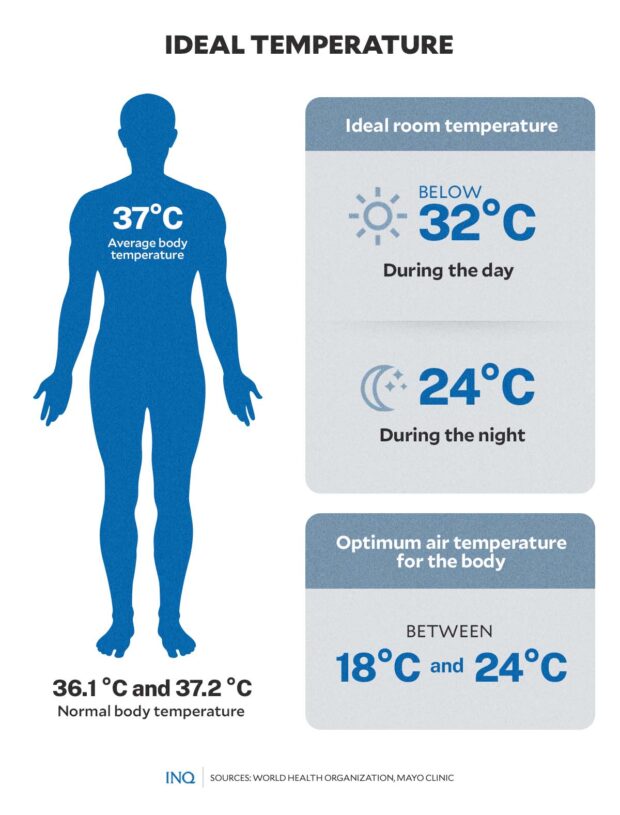
GRAPHIC Ed Lustan
According to the US-based nonprofit organization Mayo Clinic, in hot weather, the body cools itself by perspiring.
The average human body temperature is at or below 37°C. When the surrounding temperature exceeds the average body temperature, the body prevents overheating through sweating or “evaporative cooling.”
However, in some conditions, sweating is not enough. In these cases—for example, when humidity is high—a person’s body temperature rises rapidly, which could damage the brain or other vital organs.
A 1958 report by the National Aeronautics and Space Administration (NASA) said that a human body can withstand environments beyond 35°C if the humidity is below 50 percent.
Using data from NASA, an infographic by Live Science showed that 1-10 days of exposure to temperatures between 50°C to 60°C under a 10 percent relative humidity could lead to death by hyperthermia—or abnormally high body temperature.
The infographic also detailed how long a human body can cope with specific temperatures and relative humidity before experiencing hyperthermia.
Wet-bulb temperature
Aside from heat index, scientists conducting climate change studies also apply another measure of heat stress called wet-bulb temperature. Wet-bulb temperature, similar to the heat index, uses air temperature and humidity data.
Given its name, the wet-bulb temperature was originally measured by wrapping a wet cloth around the bulb of a thermometer and exposing it to air. As the water from the cloth evaporates, the thermometer records the drop in temperature.
“Wet-bulb temperature is the lowest temperature to which an object can cool down when moisture evaporates from it,” said NASA.
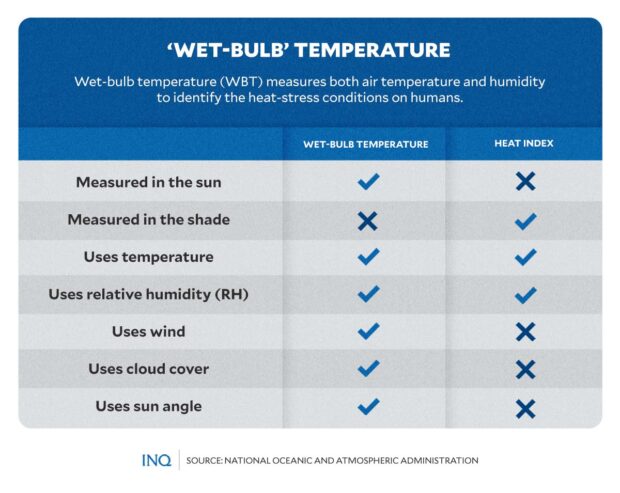
GRAPHIC Ed Lustan
“The lower the wet-bulb temperature, the easier it is for us to cool down. It measures how well our bodies cool down by sweating when it’s hot and humid, and tells us if conditions may be harmful to our health, or even deadly,” it added.
According to Colin Raymond, of NASA’s Jet Propulsion Laboratory in Southern California and who was also the lead author of a 2020 study on extreme heat and humidity, the highest wet-bulb temperature that a human body can survive for at least six hours is around 35°C.
“Once the wet-bulb temperature exceeds 35 degrees Celsius (95 degrees Fahrenheit), no amount of sweating or other adaptive behavior is enough to lower your body to a safe operating temperature,” said Raymond.
“Most of the time it’s not a problem, because the wet-bulb temperature is usually 5-to-10 degrees Celsius below body temperature, even in hot, humid places,” he added.
However, he warned that in humid areas experiencing extreme temperatures and a wet-bulb temperature of between 34°C to 36°C, people could not survive for extended periods of time.
Specifically, the elderly, people who work outside, those with underlying health issues, and those without air conditioning are most vulnerable to high wet-bulb temperatures.
When bodies overheat
According to the World Economic Forum, citing data from Australia Wide First Aid, when the body temperature goes beyond 37°C, the person might experience heat exhaustion.
The US Centers for Disease Control and Prevention (CDC) said among the warning signs of heat exhaustion are heavy sweating, muscle cramps, weakness, headache, dizziness, nausea, vomiting, muscle cramps, and fainting.
READ: Extreme heat in PH: Health risks, economic impact
Meanwhile, when body temperature shoots up to over 40°C, a person may experience heat stroke—identified by the Department of Health (DOH) as the most severe form of heat-related illness.
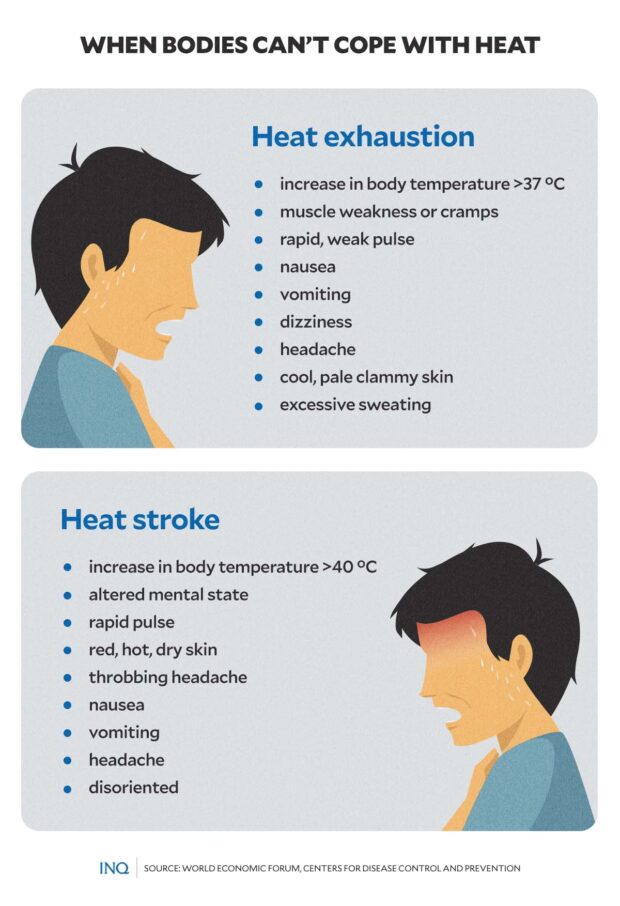
GRAPHIC Ed Lustan
Among the emergency measures that should be taken when someone is suffering from heat stroke are:
- moving the person to a shady spot or indoors
- have them lie down with their legs elevated
- have the victim drink cool water
- remove clothing and apply cool water to the skin
- fan the person
- apply ice packs to the armpits, wrists, ankles, and groin.
READ: Explainer: How to beat ‘heatstroke’ during the summer season
The health department stressed that heat stroke is a medical emergency and that the patient should be rushed to the hospital after instituting emergency measures.
To prevent heat stroke—as well as other heat illnesses—the DOH provided the following tips:
- Limit the amount of time you spend outdoors.
- Drink plenty of water.
- Avoid tea, coffee, soda, and alcohol.
- Schedule heavy-duty activities for the beginning or end of the day when it’s cooler.
The CDC also recommended the following:
- Choose lightweight, light-colored, loose-fitting clothing.
- Cut down on exercise or strenuous activities during the heat.
- Wear sunscreen.
- Avoid hot and heavy meals.
In addition, Johns Hopkins Medicine advised the public to opt for water and sports drink and limit the intake of caffeinated tea, coffee, soda, and alcohol, as these can lead to dehydration.
It also recommended people with chronic conditions to talk with their health care provider about extra precautions to protect themselves against heat stroke.
